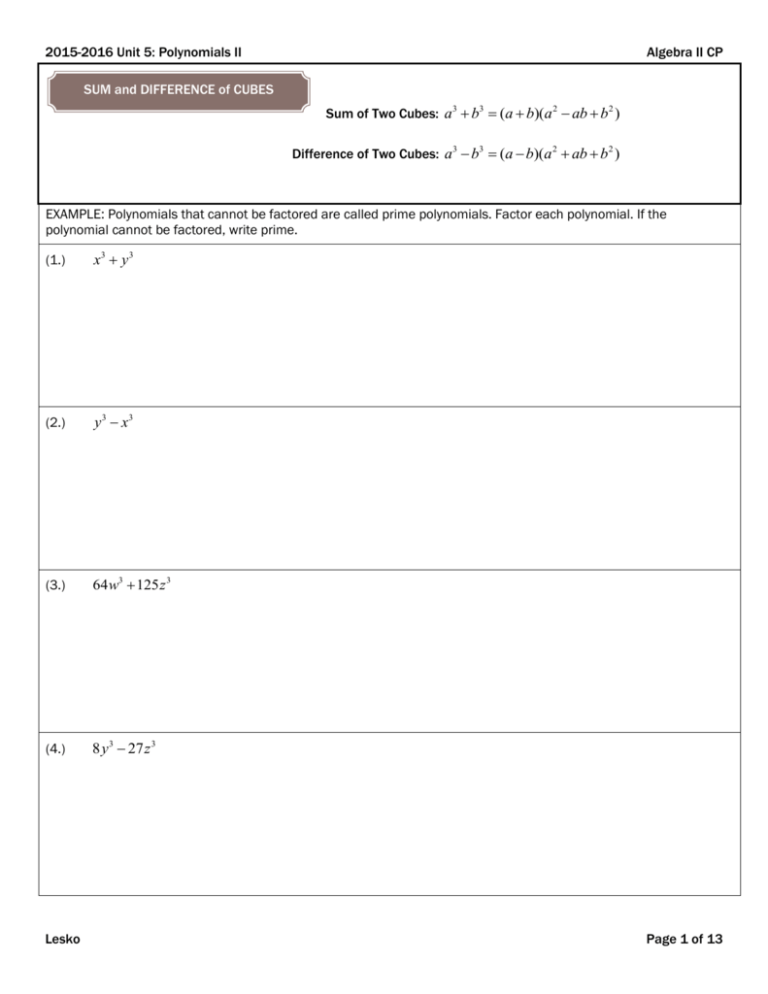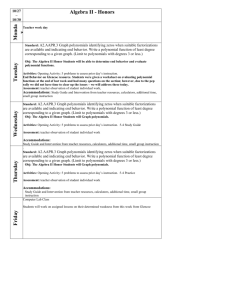New Notes
advertisement

2015-2016 Unit 5: Polynomials II Algebra II CP SUM and DIFFERENCE of CUBES Sum of Two Cubes: a3 b3 (a b)(a 2 ab b 2 ) Difference of Two Cubes: a3 b3 (a b)(a 2 ab b 2 ) EXAMPLE: Polynomials that cannot be factored are called prime polynomials. Factor each polynomial. If the polynomial cannot be factored, write prime. (1.) x3 y 3 (2.) y 3 x3 (3.) 64 w3 125 z 3 (4.) 8 y 3 27 z 3 Lesko Page 1 of 13 2015-2016 Unit 5: Polynomials II Algebra II CP EXAMPLE: COMPLETELY Factor each polynomial. If the polynomial cannot be factored, write prime. (5.) x3 5 x 2 2 x 10 (6.) a 2 3ay 2ay 2 6 y 3 (7.) 3 x 4 12 x 2 15 (8.) 2 x 4 8 x 2 42 Lesko Page 2 of 13 2015-2016 Unit 5: Polynomials II Algebra II CP (9.) 9 x 4 30 x 2 25 (10.) x 4 16 x 2 64 (11.) x4 y 4 (12.) 9 x 4 16 y 4 (13.) x6 y 6 (14.) x6 y 6 Lesko Page 3 of 13 2015-2016 Unit 5: Polynomials II Algebra II CP EXAMPLE: SOLVE the polynomials (FIND THE ZEROS – X INTERCEPTS – ROOTS) (15.) 18 x 4 21x 2 3 0 (16.) 4 x4 8x2 3 0 (17.) 8 x 4 10 x 2 12 0 (18.) x 4 29 x 2 100 0 Lesko Page 4 of 13 2015-2016 Unit 5: Polynomials II REMAINDER THEOREM Algebra II CP If a polynomial P ( x ) is divided by x r , the remainder is a constant P ( r ) , where Q ( x) is a polynomial with degree one less than P ( x ) . EXAMPLE: Find the remainder. (19.) f ( x) 3x3 6 x 2 x 11 , find f (3) (20.) f ( x) 4 x5 2 x3 x 2 1 , find f ( 1) EXAMPLE: Determine whether the binomial is a factor. If the factor is a remainder, then find the remaining. (21.) Lesko Determine whether x 5 is a factor of x3 7 x 2 7 x 15 . (22.) Determine whether x 2 is a factor of x3 7 x 2 4 x 12 . Page 5 of 13 2015-2016 Unit 5: Polynomials II (23.) Determine whether x 3 is a factor of x3 4 x 2 15 x 18 . FUNDAMENTAL THEOREM OF ALGEBRA Algebra II CP (24.) Determine whether x 1 is a factor of 2 x3 17 x 2 23x 42 . Every polynomial equation with a degree greater than zero has at least one root in the set of complex numbers. *Note: Real Numbers and Imaginary Numbers both belong to the Complex Numbers * EXAMPLE: Solve each equation. State the number and type of roots. (25.) Lesko x2 6x 9 0 (26.) x3 25 x 0 Page 6 of 13 2015-2016 Unit 5: Polynomials II Algebra II CP (27.) x 4 16 0 (28.) x5 8 x3 16 x 0 (29.) y 4 256 0 (30.) 3x3 x 2 9 x 3 0 A polynomial equation of degree n has exactly n roots in the set of complex numbers, including repeated roots. Descartes’ Rule of Signs Corollary to the Fundamental Thereon of Algebra The number of positive real zeros of P(x) is the same as the number of changes in sign of the coefficients of the terms, or is less than this by an even number, and The number of negative real zeros of P(x) is the same as the number of changes in sign of the coefficients of the terms of P(-x), or is less than this by an even number. Lesko Page 7 of 13 2015-2016 Unit 5: Polynomials II Algebra II CP EXAMPLE: State the possible number of positive real zeros, negative real zeros, and imaginary zeros. (31.) f ( x) x 6 3 x 5 4 x 4 6 x 3 x 2 8 x 5 (32.) f ( x) 2 x 5 x 4 3x 3 4 x 2 x 9 (33.) f ( x) x 6 4 x 3 2 x 2 x 1 (34.) f ( x) x 4 2 x 2 5 x 19 Lesko Page 8 of 13 2015-2016 Unit 5: Polynomials II COMPLEX CONJUGATES THEOREM Algebra II CP Let a and b be real numbers, and b cannot be zero. If a bi is a zero of a polynomial function with real coefficients, then a bi is also a zero of the function. EXAMPLE: Write a polynomial function. (35.) The zeros include -1, -6, -8 (37.) The zeros include 4 and 4 i Lesko (36.) The zeros include -2, 5, -7 Page 9 of 13 2015-2016 Unit 5: Polynomials II Algebra II CP Rational Zero Theorem If P(x) is a polynomial function with integral coefficients, then every rational zero of P(x) = 0 is of the form p , q a rational number in simplest form, where p is a factor of the constant term and q is a factor of the leading coefficient term. Corollary to the Rational Zero Theorem If P(x) is a polynomial function with integral coefficients, a leading coefficient of 1, and a nonzero constant term, then any rational zeros of P(x) must be factors of the constant term. EXAMPLE: List all the possible rational zeros of the function. (38.) f ( x) 4 x5 x 4 2 x3 5x 2 8x 16 (39.) f ( x) x3 3x 2 5x 12 (40.) f ( x) 3x3 4 x 10 (41.) f ( x) x3 11x 2 24 Lesko Page 10 of 13 2015-2016 Unit 5: Polynomials II Algebra II CP EXAMPLE: Find all of the zeros. (42.) Lesko f ( x) 5 x 4 8 x3 41x 2 72 x 36 Page 11 of 13 2015-2016 Unit 5: Polynomials II (43.) Lesko Algebra II CP f ( x) 2 x 4 5x3 20 x 2 45x 18 Page 12 of 13 2015-2016 Unit 5: Polynomials II (44.) Algebra II CP Graph the function p x x 2 x 1 x 1 using its zeros. 80 70 60 50 40 30 20 10 -7 -6 -5 -4 -3 -2 -1 1 2 3 4 5 -10 -20 -30 -40 -50 -60 -70 (a) Even or Odd: (b) Start and End Behavior: (b) x-intercepts: (d) Number of Turning Points: (e) y-intercepts: (f) Local minima: (g) Local maxima: Lesko Page 13 of 13








